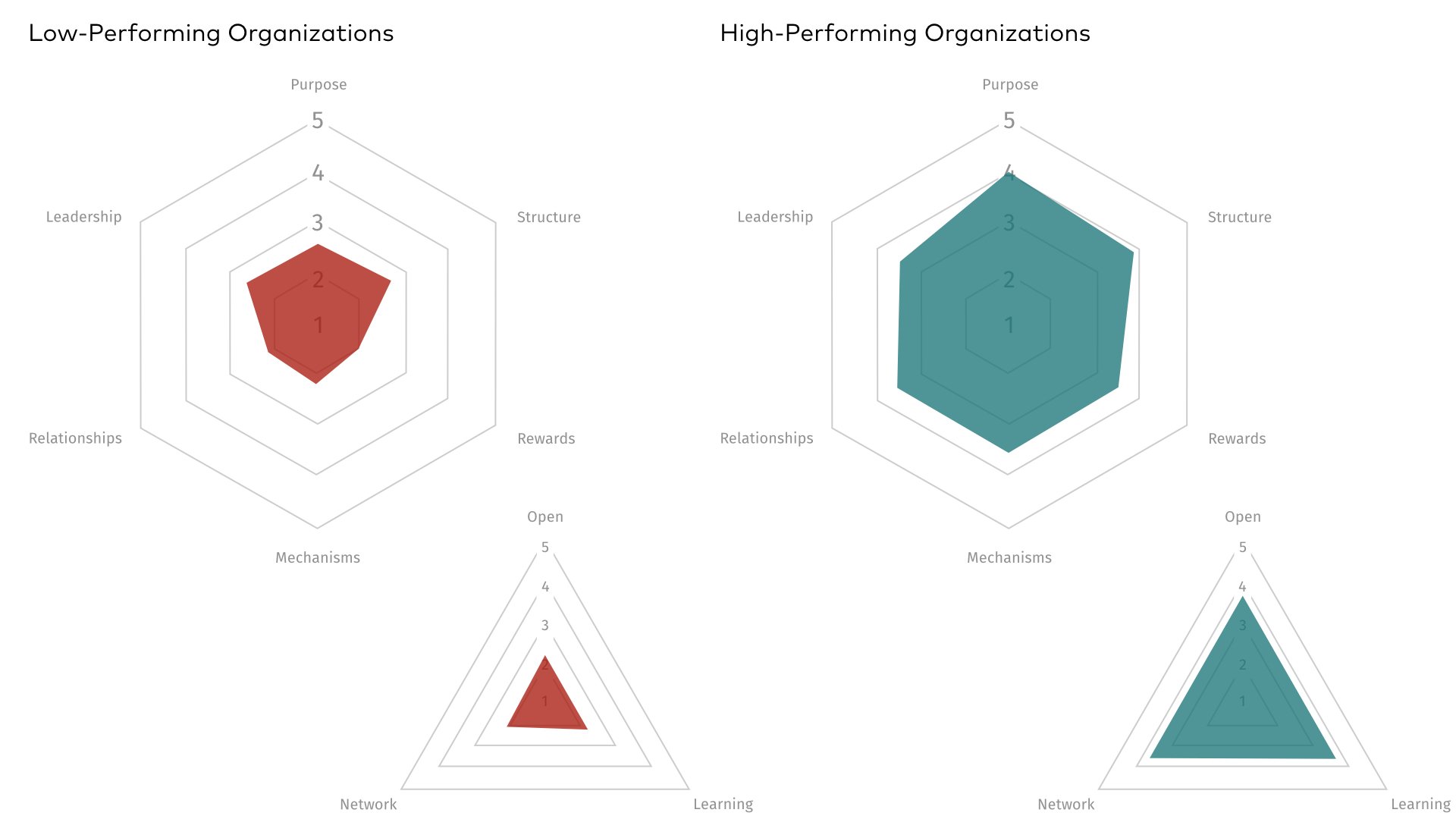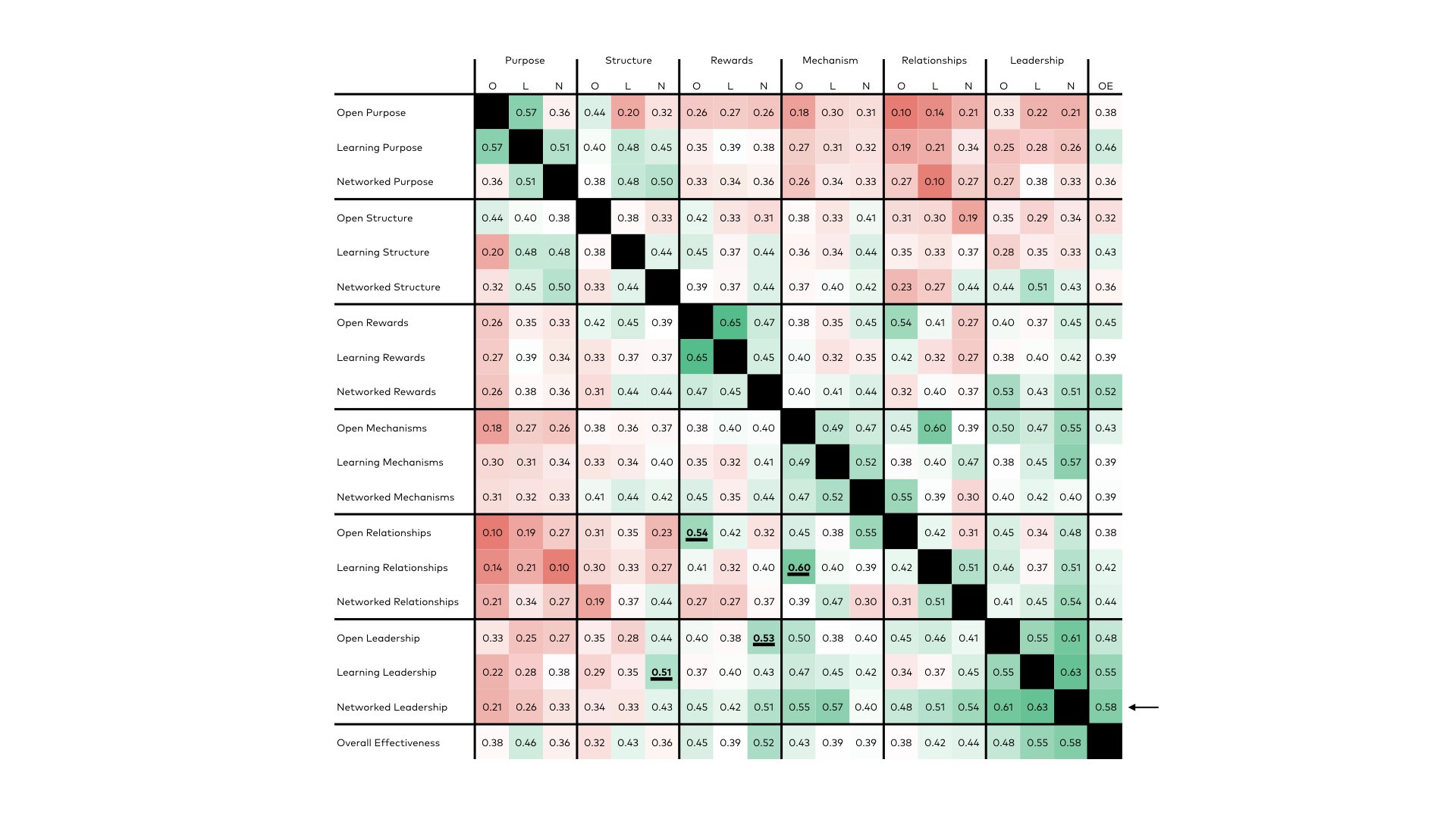Published February 21, 2019 | Updated April 15, 2019 | 5 minute read
At our January 2019 Summit (our tenth one!) we worked as a team to come up with a few different concepts for assessing the design quality of organizations. What follows is a description of our first version of one of these concepts – and some interesting findings.
In general, we believe that the next generation of organizations – the ones that define what success looks like in a world dominated by uncertainty and technological advancement – will be Open Learning Networks (OLNs).
This initial assessment is designed to see how much an org matches up to our definition of an OLN. In order to get there, we built off Marvin Weisbord's Six Box assessment model: Purpose; Structure; Rewards; Helpful Mechanisms; Relationships; Leadership. For each box, we created three questions, one for each of Open, Learning, and Network. (You can take the survey, and see the questions, here.)
We then ran this survey with a few friends to test it out, and used it in a few client situations to test its fit for purpose: does it give us a good sense of the dysfunctions of an organization, and does it give designers clues for where to intervene, and how?
Turns out: it sorta works!The data in this post are from 158 US employees of large (more than 10,000 employees) organizations.
We also asked them to evaluate the effectiveness/performance of their organizations – ideally helping us understand if organizations are better off if they are OLNs, or not.

So...high-performance orgs scored higher than their low-performance peers – which was to be expected.
What was more interesting to me was the relationship between the responses. If organizations have open rewards systems, what happens? If they exhibit a networked structure, how do relationships change?
What we found was encouraging.

Above is a heatmap of how each individual response was correlated with other responses in the survey. That is: if you rate your purpose as open, what other attributes are you likely to rate highly, too? The deep green blocks indicate fairly strong correlation, and the red blocks indicate a much weaker connection.
It seems obvious, for example, that an open rewards system, where everyone knows what the rewards are and how to earn them, would be connected to a rewards system that learns and adapts over time.
Purpose
What was strange to us, though, was that OLN purpose was hardly predictive of anything else. The people we surveyed in general gave their org purpose higher marks than any other attribute: they said it was clear, that it adapted with time, and that it inspired action above and beyond stated job descriptions. This lines up with our experiences working with purpose-driven organizations: just having a good purpose doesn't itself result in great structure, relationships, or org effectiveness.
Learning
When looking at collections of variables – how a respondent assessed each question targeted at OLN or any of the Six Boxes – we found that high scores in learning correlated more with overall effectiveness than any other collection of variables. This lines up with an overall hypothesis of our firm: organizations that are designed to learn, instead of being designed to be efficient, will become more open and networked over time, and will achieve greater success. I think we're on to something.
Leadership
Leadership in general was the most predictive of high scores in other attributes, but networked leadership in particular was a powerful predictor across the survey.
We've observed that formal Leadership plays an enormous role in the creation and maintenance of an OLN. Specifically, it's their ability to capture and act upon knowledge from the edge of the organization that makes the difference, providing crucial fuel for continuous organization.
Networked Leadership: When the working teams I'm a part of surface tensions we experience to the rest of the organization, we felt heard and understood
Your agreement to this statement was predictive of your responses to seven other attributes: Networked Rewards, Open & Learning Mechanisms, Learning & Networked Relationships – as well as Open and Learning Leadership. But most interesting, the strength of Networked Leadership was able to predict 60% of the variability in overall effectiveness as an organization.
A few other connections stood out. Open rewards were predictive of open relationships. This makes obvious sense: having a clear sense of what helps people get ahead removes the angst of working out folks' political motivations.
Open Rewards: Rewards (e.g. promotions, awards, extra benefits, etc.), and how to earn them, are clear and transparent to everyone
is connected to...
Open Relationships: It is easy to find out what projects other employees, outside of the working teams I'm a part of, are working on
Open mechanisms were predictive of learning relationships. Being able to find out what others are working on makes conversations about working relationships more straightforward, and prevents confusion about who's doing what (and why) – a source of significant conflict in every firm we've ever observed. This also works the other way around; fostering a sense of psychological safety within a team makes it easier to expose the team's work to the rest of the org.
Open Mechanisms: The working teams I'm a part of can easily discover similar work in other parts of the company
is connected to...
Learning Relationships: On the working teams I'm a part of, we have regular conversations about how to improve our working relationships
Open leadership was predictive of networked rewards, and learning leadership was predictive of networked structure. While an organization's purpose should give folks permission to do whatever is necessary to help the organization more forward, clarity and transparency of decision-making enables and supports helping others even over helping yourself.
Open leadership: I am aware of and understand top-level decision-making and strategy
is connected to...
Networked rewards: I am incentivized to help others above and beyond my day to day responsibilities
And perhaps my favorite result from the entire survey: regular feedback loops with leaders support distributed authority. When direct reports are in continuous, open negotiation around decision rights, things just seem to get better with every passing day. When they're not, things get worse.
Learning leadership: Leaders invite feedback regularly, and I feel comfortable giving it to them
is connected to...
Networked structure: I have clear autonomy over the decisions necessary to get my work done
Next Steps
From here, we plan to improve the instrument to get more clarity on cause and effect – to accurately describe the design variables that are most predictive of success.
In the meantime, if you'd like to work with us to build a winning OLN in place of traditional hierarchy, we're here to help.
Obviously there are a ton of caveats here – this is self-reported data; we haven't yet really done any factor analysis or worked to eliminate bias through the survey method and wording of the questions. And as ever, correlation isn't causation – but it sure is interesting.








